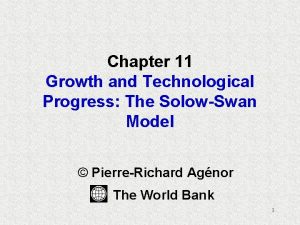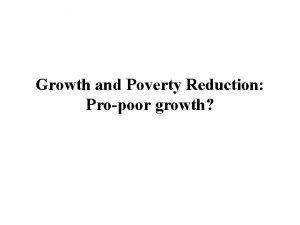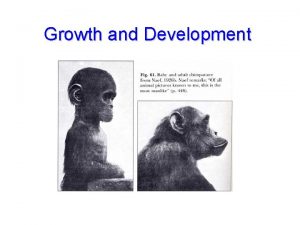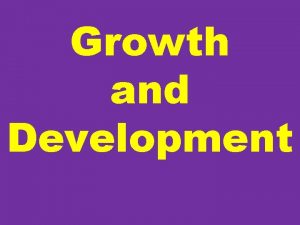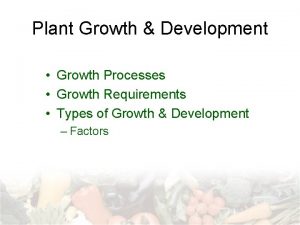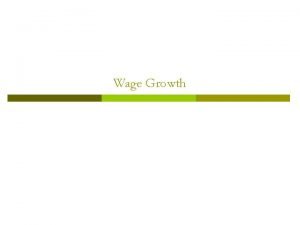Technological Progress and Growth Technological Progress and the




















- Slides: 20

Technological Progress and Growth

Technological Progress and the Rate of Growth § Technological progress has many dimensions. It may mean: – Larger quantities of output – Better products – New products – A larger variety of products § Technological progress leads to increases in output for given amounts of capital and labor.

Technological Progress and the Production Function § Let’s denote the state of technology by A and rewrite the production function as § A more restrictive but more convenient form is § Output depends on both capital and labor, and on the state of technology.

Technological Progress and the Production Function § Technological progress reduces the number of workers needed to achieve a given amount of output. § Technological progress increases AN, which we can define as the amount of effective labor in the economy. § With constant returns to scale,

Technological Progress and the Production Function § As in the previous framework, the relation between output per effective worker and capital per effective worker is:

Technological Progress and the Production Function Output per Effective Worker Versus Capital per Effective Worker

Assumptions § We now relax the two assumptions we used before (in Chapter 11): 1. The number of workers (the population) is growing at a constant (exogenous) rate. 2. Technology is improving at a constant (exogenous) rate.

Interactions Between Output and Capital In a Steady State § The amount of investment per effective worker needed to maintain a constant level of capital per effective worker is As before, in the steady state, this expression will equal investment (per effective worker)

Interactions Between Output and Capital Dynamics of Capital per Worker and Output per Effective Worker

Dynamics of Capital and Output In the steady state: § Output per effective worker is constant. § Output per worker grows at a rate (g. A). § Output growth equals (g. A+g. N). § The growth rate of output in the steady state is independent of the saving rate. § Capital and effective labor also grows at a rate equal to (g. A+g. N). § Because output, capital, and effective labor all grow at the same rate, (g. A+g. N), the steady state of the economy is also called a state of balanced growth.

Dynamics of Capital and Output The Characteristics of the Steady State Rate of growth of: Chap. 12 Chap. 11 1 Capital per effective worker 0 2 Output per effective worker 0 3 Capital per worker g. A 0 4 Output per worker g. A 0 5 Labor g. N 0 6 Capital g. A + g. N 0 7 Output g. A + g. N 0

The Determinants of Technological Progress § Technological progress in modern economies is the result of research and development (R&D) activities. § Private spending on R&D depends on: – The fertility of the research process, or how spending on R&D translates into new ideas and new products, and – The appropriability of research results, or the extent to which firms benefit from the results of their own R&D.

The Fertility of Research § The determinants of fertility include: – The interaction between basic research and applied research. – The institutional environment: education levels, firms characteristics, legal frameworks, etc. – Time: It might take many years for the full potential of major discoveries to be realized.

The Appropriability of Research Results § If firms cannot appropriate the profits from the development of new products, they will not engage in R&D. § Factors at work include: – The nature of the research process. Is there a payoff in being first? – Legal protection. Patents give a firm that has discovered a new product the right to exclude anyone else from the production or use of the new product for a period of time.

Capital Accumulation Versus Technological Progress Average Annual Rates of Growth of Output per Capita and of Technological Progress Growth of Output per Capita Rate of Technological Progress 1950 -73 (1) 1973 -87 (2) Change (3) 1950 -73 (4) 1973 -87 (5) Change (6) France 4. 0 1. 8 2. 2 4. 9 2. 3 2. 6 Germany 4. 9 2. 1 2. 8 5. 6 1. 9 3. 7 Japan 8. 0 3. 1 4. 9 6. 4 1. 7 4. 7 United Kingdom 2. 5 1. 8 0. 7 2. 3 1. 7 0. 6 United States 2. 2 1. 6 0. 6 2. 6 0. 6 2. 0

Capital Accumulation Versus Technological Progress § The table illustrates three main facts: 1. The earlier period of high growth of output per capita was due to rapid technological progress. 2. The slowdown in growth of output per capita since 1973 has come from a decrease in the rate of technological progress. 3. Convergence of output per capita across the rich countries has come from higher technological progress rather than from

Why Did Technological Progress Slow Down in the mid-1970 s? Spending on R&D as a Percentage of GDP 1963 1975 1989 France 1. 6 1. 8 2. 3 Germany 1. 4 2. 2 2. 9 Japan 1. 5 2. 0 3. 0 United Kingdom 2. 3 2. 0 2. 3 United States 2. 7 2. 3 2. 8

TFP Growth

Science Education

Epilogue § We still cannot explain well enough why some countries grow more than others. § There seem to be many different reasons for the vastly different growth performances across countries (and to a lesser extent across time).
 Physical progress and financial progress
Physical progress and financial progress Relative growth rates
Relative growth rates Monocot vs eudicot
Monocot vs eudicot Primary growth and secondary growth in plants
Primary growth and secondary growth in plants Vascular ray
Vascular ray Growthchain
Growthchain Geometric vs exponential growth
Geometric vs exponential growth Neoclassical growth theory vs. endogenous growth theory
Neoclassical growth theory vs. endogenous growth theory Organic growth vs inorganic growth
Organic growth vs inorganic growth Hình ảnh bộ gõ cơ thể búng tay
Hình ảnh bộ gõ cơ thể búng tay Ng-html
Ng-html Bổ thể
Bổ thể Tỉ lệ cơ thể trẻ em
Tỉ lệ cơ thể trẻ em Gấu đi như thế nào
Gấu đi như thế nào Chụp phim tư thế worms-breton
Chụp phim tư thế worms-breton Bài hát chúa yêu trần thế alleluia
Bài hát chúa yêu trần thế alleluia Kể tên các môn thể thao
Kể tên các môn thể thao Thế nào là hệ số cao nhất
Thế nào là hệ số cao nhất Các châu lục và đại dương trên thế giới
Các châu lục và đại dương trên thế giới Công thức tính thế năng
Công thức tính thế năng Trời xanh đây là của chúng ta thể thơ
Trời xanh đây là của chúng ta thể thơ
























